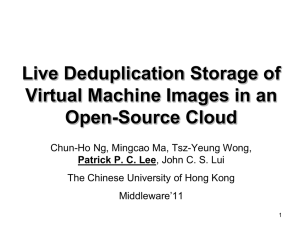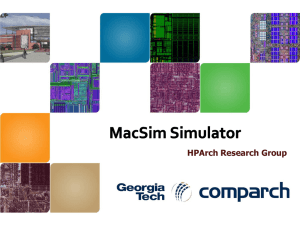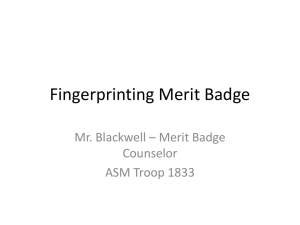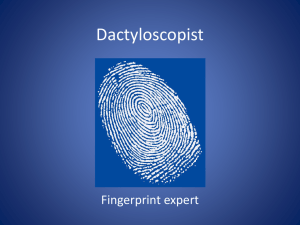PPT
advertisement
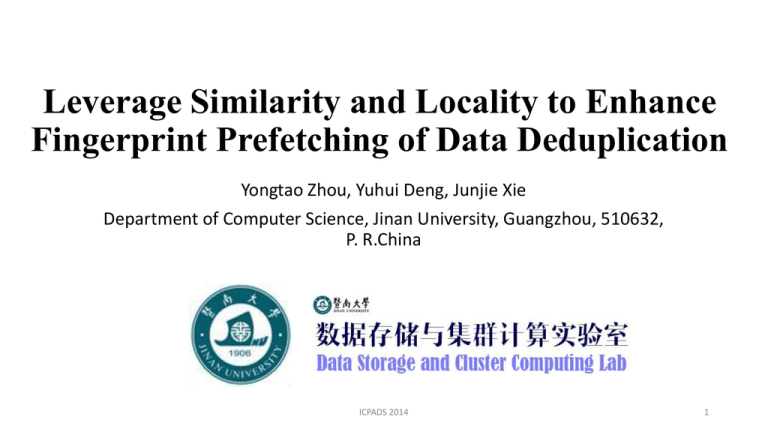
Leverage Similarity and Locality to Enhance Fingerprint Prefetching of Data Deduplication Yongtao Zhou, Yuhui Deng, Junjie Xie Department of Computer Science, Jinan University, Guangzhou, 510632, P. R.China ICPADS 2014 1 Agenda • Introduction • Related work • Motivation • System overview • Evaluation ICPADS 2014 2 Introduction • IDC: 95% redundant data in the backup systems; 75% redundant data across the digital world Consumes IT resources and expensive network bandwidth • Data deduplication: eliminate redundant data by storing only one data copy Fingerprint Chunk algorithm Files Fingerprints to large too store all fingerprints in memory MD5 Data blocks Hash Table B+ Tree A B G ICPADS 2014 E C 3 Introduction • Querying fingerprints incurs disk bottleneck The size of fingerprints are too large too be cached in memory Cache hit ration very low (lack temporal locality) The IOPS of disk drivers is limited 800TB unique data MD5 signature Avg.8KB Chunk A large portion of fingerprints have to be stored on disk drives ICPADS 2014 4 Locality based strategies: DDFS • Locality: segments tend to reappear in the same or very similar sequences with other segments. This is because most data from previous backup has a slight modifications. RAM Prefetching!!!! Index A B C A ... Bloom Filter ... A E I A ABC DE F H I J Poor deduplication performance when there is little or no locality in datasets ? ICPADS 2014 5 Similarity based method: Extreme Binning RAM DISK Similarity Index C1 C2 Cn Bin(C1) Files Bin(C2) Bin(Cn) Fail to identify and thus remove significant amounts of redundant data when there is a lack of similarity among files It uses a two-leve lindex structure made up of similarity characteristic value and the granularity of bin. Extreme Bining stores the similarity characteristics value in RAM. Extreme Bining only identifies the redundant data in the same bin, even though neighbouring bins may have identical data blocks. This results in some redundant data blocks so as to degrade the deduplication ratio. the deduplication ration of Extreme Bining heavily relies on the similarity degree of data streams. ICPADS 2014 6 SSD based approach • Fingerprint lookup disk bottleneck The IOPS of disk drive is limited HDD VS SSD • Some studies alleviate disk bottleneck by using SSD Dedupv1, ChunkStash • SDD is still very expensive in contrast to disk drives. • The performance of random and small writes becomes a new bottleneck of SSD ICPADS 2014 7 Our approach • A fingerprint prefetching approach by using the file similarity to enhance the deduplication performance • The locality of fingerprints are maintained by arranging the fingerprints in terms of the sequence of the backup data stream • The overhead of different similarity identification algorithms are investigated, and the impacts of those algorithms on data deduplication are evaluated in contrast to previous studies Extreme Binning, Silo, FPP • This approach does not impact the deduplication ration ICPADS 2014 8 System architecture Implementation in LessFS Implementation in Tokyo Cabinet ICPADS 2014 9 Storage structure for fingerprints The locality of fingerprints are maintained by arranging the fingerprints in terms of the sequence of the backup data stream Loss the locality of fingerprints ICPADS 2014 10 The process of fingerprints prefetching ICPADS 2014 11 Evaluation • Implement a real prototype based on LessFS and Tokyo Cabinet • Three similarity identification algorithms FPP, PAS and Simhash are implemented in the Similar File Identification Module • Ubuntu operation system(Kernel version is 3.5.0-17) ,1GB memory, 2:4GHz Intel(R) Xeon(R) CPU • We take four full backups to evaluate the system like what DDFS does. • Four data sets backup1, backup2, backup3 and backup4 to perform the evaluation 10GB, 15GB, 20GB and 25GB, and the numbers of files are 3073, 4694, 6539 and 9910, respectively. We choose fixed-size chunk algorithm. The chunk size is 4KB, 8KB, 16KB, 32KB, 64KB and 128KB ICPADS 2014 12 FPP and PAS ICPADS 2014 13 Simhash • Simhash is a member of the local sensitive hash • Simhash has the property that the fingerprints of similar files differ in a small number of bit positions • Actual runs at Google web search engine ICPADS 2014 14 Data sets The file size distribution matches the previous studies. ICPADS 2014 15 Deduplication ratio • We measure the size of unique data blocks by using three different similarity identification algorithms including FPP, PAS and Simhash with four full backups • When the chunk size is 4KB, the unique data blocks are 14GB, and the data deduplication ratios are 3.93 across the three cases. • The performance is the same as that of the baseline system LessFS. ICPADS 2014 16 Time overhead of fingerprint lookup • 𝑇𝑠 : the time of similarity detection • 𝑇𝑝 : the time of fingerprint prefetch • 𝑇𝑓 : the time of fingerprint lookup • The overall overhead of fingerprint lookup 𝑇𝑡 = 𝑇𝑠 + 𝑇𝑝 + 𝑇𝑓 • For Base has 𝑇𝑠 = 𝑇𝑝 = 0 ICPADS 2014 17 Time overhead of fingerprint lookup ICPADS 2014 18 CPU utilization ICPADS 2014 19 Memory utilization ICPADS 2014 20 Conclusion • Proposes a fingerprint prefetching approach by preserving the locality of fingerprint in the form of backup data stream as well as taking advantage of file similarity • The proposed method can effectively alleviate the disk bottleneck with acceptable overhead of CPU, memory, and storage when performing fingerprint lookup, thus improving the throughput of data deduplication • Does not impact the data deduplication ratio ICPADS 2014 21 Reference • • • • • • • • • • • • • • • • SSD: http://en.wikipedia.org/wiki/Solid-state_drive HDD vs SSD: http://www.diffen.com/difference/HDD_vs_SSD D. Bhagwat, K. Eshghi, D. D. Long, and M. Lillibridge, “Extreme binning: Scalable, parallel deduplication for chunk-based file backup,” in Modeling, Analysis & Simulation of Computer and Telecommunication Systems, 2009. MASCOTS’09. IEEE International Symposium on. IEEE, 2009, pp. 1–9. W. Xia, H. Jiang, D. Feng, and Y. Hua, “Silo: a similarity-locality based near-exact deduplication scheme with low ram overhead and high throughput,” in Proceedings of the 2011 USENIX conference on USENIX annual technical conference. USENIX Association, 2011, pp. 26–28. A. Z. Broder, M. Charikar, A. M. Frieze, and M. Mitzenmacher, “Min-wise independent permutations,” Journal of Computer and System Sciences, vol. 60, no. 3, pp. 630–659, 2000. Y. Zhou, Y. Deng, X. Chen, and J. Xie, “Identifying file similarity in large data sets by modulo file length,” in Proceedings of the 14th International Conference on Algorithms and Architectures for Parallel Processing. IEEE, 2014. D. Meister and A. Brinkmann, “dedupv1: Improving deduplication throughput using solid state drives (ssd),” in Mass Storage Systems and Technologies (MSST), 2010 IEEE 26th Symposium on. IEEE, 2010, pp. 1–6. B. Debnath, S. Sengupta, and J. Li, “Chunkstash: speeding up inline storage deduplication using flash memory,” in Proceedings of the 2010 USENIX conference on USENIX annual technical conference. USENIX Association, 2010, pp. 16–16. Y. Deng, “What is the future of disk drives, death or rebirth?” ACM Computing Surveys (CSUR), vol. 43, no. 3, p. 23, 2011. B. Zhu, K. Li, and R. H. Patterson, “Avoiding the disk bottleneck in the data domain deduplication file system.” in Fast, vol. 8, 2008, pp. 1–14. J. Gantz and D. Reinsel, “The digital universe decade-are you ready,” IDC iView, 2010. S. Quinlan and S. Dorward, “Venti: A new approach to archival storage.” in FAST, vol. 2, 2002, pp. 89–101. M. Ruijter, “Lessfs,” http://www.lessfs.com/wordpress/. F. Labs, “Tokyo cabinet,” http://fallabs.com/tokyocabinet/. M. Lillibridge, K. Eshghi, D. Bhagwat, V. Deolalikar, G. Trezis, and P. Camble, “Sparse indexing: Large scale, inline deduplication using sampling and locality.” in Fast, vol. 9, 2009, pp. 111–123. G. S. Manku, A. Jain, and A. Das Sarma, “Detecting nearduplicates for web crawling,” in Proceedings of the 16th international conference on World Wide Web. ACM, 2007, pp. 141–150. ICPADS 2014 22 Thank you! Question? ICPADS 2014 23
